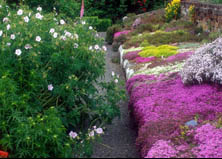Roman herbs & astilbes

The acanthus in the Roman garden looks wonderfully sculptural at this time of the year; hardly surprising then, that its leaves were the inspiration for the capitals on Corinthian columns. The tall flower heads are really very prickly, but the flowers dry well, keeping their colour without collapsing which can be unusual for white petals. Any that hang over the path get cut and put in the shop for flower arrangers to buy fresh or dried. The Roman garden is divided into four beds; two of culinary herbs, one of medicinal and one of sacred herbs, and it is in this last bed that the Acanthus is planted. Next to it is a large bush of myrtle, a plant long associated with love, sprigs of which are put into wedding bouquets. (Queen Victoria had myrtle in hers) Its young leaves when squeezed smell of bubble gum!
Also in the sacred herb bed is vervain which was dedicated to goddesses, firstly to Isis and then to Venus. Roman women would make small garlands of vervain (and also violets and lavender, both in our Roman garden) to lay on the household altar. We know it was used in Britain thanks to archaeological evidence - pollen grains were found during digs at Roman Silchester in Berkshire.

There is plenty I could write about our Roman garden and I'll concentrate on cooking herbs in a future blog. For now, let me show a picture of how the astilbe border looks right now. As the walled garden is south facing and free draining, the only place to put damp-loving plants is in the shade of the bottom wall. In a normal summer when the rest of the garden gets hot and dry, the astilbes can revel in the moist soil down there, alongside some of the hostas, but lack of rain has not exactly been a problem this year! The astilbes self-seed happily and I love their various shades of pink, from candyfloss to deep salmon mixed in with some whites. There was goats beard in this border just before the astilbes came into flower - Aruncus silvester - a lovely white fluffy effect, but I have cut all the flower stalks out now because when over they go a sad shade of brown. Early August is a time of massive cutting back all over the garden, to allow fresh foliage to come through and to stop too much self-seeding; some is wonderful and looks natural, too much can be too much - it's a careful juggling act!


2 comments:
I was searching for info on the Romans and found this blog which is great and I hope there will be more on their herbs. What did the Romans do for us? ....
It is wonderful how archaeological botanists can identify pollen from so long ago. A lot has also been found at Fishbourne near Chichester. And as for those wonderful Pompeian gardens....
Susie, you should have a Roman cookery day with recipes from Apicius and herbs from your gsrden. Don't know what you would cook on, but let's not give up at the first obstacle!
Post a Comment